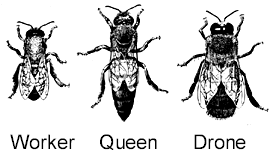The Honey Bee Colony - an example of Social Insects

Three types of honey bees normally found in a honey bee colony
Honey bees are social insects. A honey bee colony typically consists of several thousand bees that cooperate in nest building, food collection, and brood rearing.
Each member has a definite task to perform, but for reproduction to be successful the entire colony must work together. Individual queens, workers, and drones cannot survive by themselves.
A colony normally has a single queen, fifty to sixty thousand workers at its peak, and several hundred drones during late spring and summer.
The social structure of the colony is maintained by the queen and workers and depends on an effective system of communication:
- The exchange of chemical secretions among members
- communicative "dances"
Queen
There is only one queen per colony. Since she is the only sexually
developed female she produces both fertilized and unfertilized eggs. One
queen may produce up to 250 000 eggs per year. The queen is the only
colony member that can live for several years, sometimes for as long as five to
seven years.
A queen is easily distinguished from other members of the colony. Her body is normally much longer than either the drone's or worker's, especially during the egg-laying period when her abdomen is greatly elongated. Her wings cover only about two-thirds of the abdomen, whereas the wings of both workers and drones nearly reach the tip of the abdomen when folded.
About one week after emerging from a queen cell, the queen is ready to leave the hive and mate with several drones in flight. The queen mates, usually in the afternoon, with up to fifteen drones.
After mating she returns to the hive and will begin laying. She releases several sperm from the spermatheca each time she lays an egg destined to become either a worker or queen.
The queen is constantly attended and fed royal jelly by the colony's worker bees. The number of eggs the queen lays depends on the amount of food she receives and the size of the worker force capable of caring for the brood. When the sperm supply begins to be depleted, the workers prepare to replace or supersede her.
Drones
Drones (male bees) are the largest bees in the colony. They are generally
present only during summer. Drones have no sting, pollen baskets, or wax
glands. Their main function is to fertilize the virgin queen during her mating
flight. Only a small percentage of drones fulful this function. They perform no
useful work for the hive.
However, the presence of a few drones is believed to improve the general
morale of the colony during the honey flow.
While drones normally rely on workers for food, they can feed themselves within
the hive after they are four days old. Since drones eat three times as much food
as workers this is quite useful. Drones stay in the hive until about eight
days old, then begin to take orientation flights. Flight from the hive normally
occurs between noon and 4:00 p.m. Drones have never been observed taking
food from flowers.
When cold weather begins in the fall and the honey flow stops, drones usually
are forced out into the cold and left to starve.
Workers
Workers are the smallest and most numerous bees in the colony. They are
sexually undeveloped females and under normal hive conditions do not lay eggs.
Workers have specialized structures, such as food glands, scent glands, wax
glands, and pollen baskets. They clean out the cells, feed the brood, care
for the queen, remove debris, handle incorning nectar, build combs, guard the
entrance, and air condition and ventilate the hive before going into the field.
In the field, they forage for nectar, pollen, water, and plant sap).
The life span of the worker during summer is about six weeks. Those reared in
the fall may live as long as six months, allowing new generations to develop
early in the spring before they die.
Brood
Eggs. Honey bee eggs are normally laid, one to a cell, by the queen.
On the third day the egg hatches into a tiny grub and the larval stage begins.
Larvae. Healthy larvae are pearly white in color with a glistening
appearance. Larvae remain pearly white, plump and glisten during the
prepupal stage.
Pupae
After two days, prepupae begin to change from their larval form to adult bees.
New workers, queens, and drones emerge approximately 12, 7 and days,
respectively, after their cells are capped.
Bee Development
Unfertilized eggs become drones, while fertilized eggs become either workers or queens.
Nutrition plays an important part in caste development of female bees.
Division of labour within the worker caste primarily depends on the age of the
bee.
Reproduction depends on the queen, the quantity of food stores, and the size of
the worker force.
As the size of the colony increases up to about sixty thousand workers, so does the efficiency of the colony.
